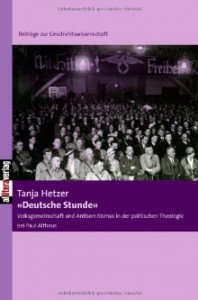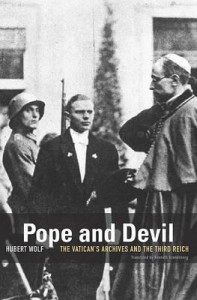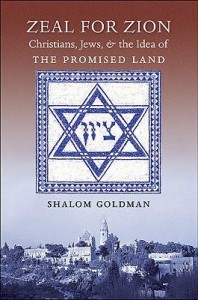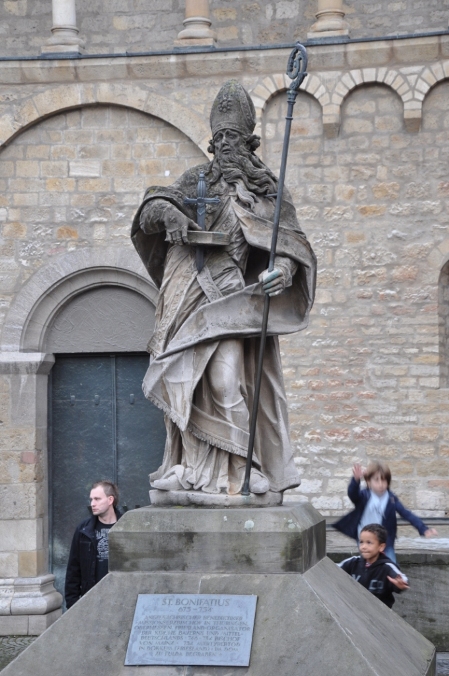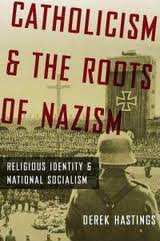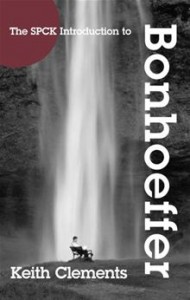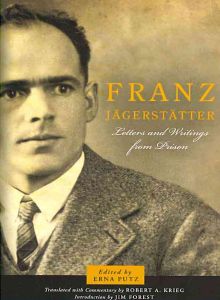ACCH Quarterly Vol. 15, No. 2, June 2010
Article Reprint: Björn Krondorfer, “Review of Susannah Heschel, The Aryan Jesus: Christian Theologians and the Bible in Nazi Germany.”
By Dr. Björn Krondorfer, St. Mary’s College of Maryland, USA
(This slightly corrected review appeared first in theologie.geschichte 4 (2009), http://aps.sulb.uni-saarland.de/theologie.geschichte/inhalt/2009/126.html, and is reprinted by kind permission of the author.)
Susannah Heschel, The Aryan Jesus: Christian Theologians and the Bible in Nazi Germany, Princeton: Princeton University Press, 2008, 384 p., U$ 29,95, ISBN: 978-0-691-12531-2.
Just recently, Germany celebrated the twentieth anniversary of the fall of the Berlin Wall, which brought to an end the GDR (East German government) and began the unification of Germany. This momentous political change quickly turned into debates about judicial and moral responsibility and the roles of history and memory—discursive ingredients quite familiar to postwar German attempts at coming to terms with the past. But from now on (1989 onwards) one could no longer talk about Vergangenheitsbewältigung in the singular but in the plural: making sense of the past now referred both to Nazism/Shoah as well to the dictatorial regime of the GDR.
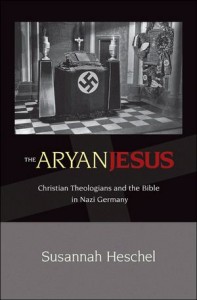 For historians, the opening of the Wall translated into archival access not only to the staggering number of files bearing witness to the surveillance apparatus of the Stasi but also to documents related to the Nazi past in the neue Bundesländer (Eastern regional states) that had hitherto been stashed away. The old East German propagandistic argument that the Nazi past was a problem only in the capitalist West crumbled in light of the evidence of the popularity of Nazism in those Eastern regions in the 1930s and 1940s. For church historians, the states of Saxony and Thuringia became of special interest since these regional churches had propagated theologies that blended völkisch-nationalist inspirations with racist-antisemitic ideologies. Back then, theologians and men of the church had weighed in heavily in support of the National Socialist regime. After 1989, it became inevitable that a new chapter on contemporary German church history would be written: it would reassess the degree of complicity of the churches with völkisch ideologies—a project undertaken by a number of German researches on the history of church and theology on local and regional levels.
For historians, the opening of the Wall translated into archival access not only to the staggering number of files bearing witness to the surveillance apparatus of the Stasi but also to documents related to the Nazi past in the neue Bundesländer (Eastern regional states) that had hitherto been stashed away. The old East German propagandistic argument that the Nazi past was a problem only in the capitalist West crumbled in light of the evidence of the popularity of Nazism in those Eastern regions in the 1930s and 1940s. For church historians, the states of Saxony and Thuringia became of special interest since these regional churches had propagated theologies that blended völkisch-nationalist inspirations with racist-antisemitic ideologies. Back then, theologians and men of the church had weighed in heavily in support of the National Socialist regime. After 1989, it became inevitable that a new chapter on contemporary German church history would be written: it would reassess the degree of complicity of the churches with völkisch ideologies—a project undertaken by a number of German researches on the history of church and theology on local and regional levels.
In the United States, theologians and religious studies scholars have had a long-standing interest in questions of ideological complicity of the German churches in the Nazi regime, not least spurred by Robert Ericksen’s Theologians under Hitler (1985). In 1996, historian Doris Bergen’s Twisted Cross expanded the research to a social and gendered analysis of the movement of “German Christians” (pro-Nazi faction of Protestant churches). In the last ten years, a new generation of American historians (not theologians!)–among them Matthew Hockenos, Kevin Spicer, Beth Griech-Pollele, Richard Steigmann-Gall, and James McNutt —has further probed the infiltration of Nazism into church and religion and investigated the continuing effects of antisemitism on postwar Germany theology.
With Susannah Heschel’s 2008 publication, The Aryan Jesus, the scholarship will yet again move a significant step forward. Heschel, who is professor of Jewish studies at Dartmouth College, synthesizes the various strands of scholarly approaches by looking at a specific group of “theologians under Hitler” within their historical embeddedness in the Nazi regime and the German university system. Her research does not stop in the year 1945 but also traces the postwar careers in West and East Germany of the men who had espoused antisemitic and völkisch theologies. In the sense that The Aryan Jesus could not have been written earlier, it is a groundbreaking work and a culmination of Heschel’s long research (which she started in 1991). The book is also the result of political changes that gave access to secreted-away church documents in the GDR as well as of new scholarly developments in the United States that created fresh conceptual frameworks for the assessment of historical material.
In her previous work, Heschel has repeatedly called attention to the many instances of theological and moral failure of German theologians during the rise of National Socialism. Rather than providing a bulwark against ideologies of hatred and exclusion—ideologies that were eventually translated into a genocidal program—churches and theologians frequently participated in and contributed to ruthlessly exclusionary systems of thought and action. Heschel frequently inserts a passionate voice into her meticulous research, which is also discernible in The Aryan Jesus. Here, she hones in on the complicity of a group of Protestant theologians who were instrumental in the creation and operation of the Entjudungsinstitut inJena, the “Institute for the Study and Eradication of Jewish Influence of German Church Life” (from now on “Institute”). Under the political/organizational leadership of pastor Siegfried Leffler and the academic/theological leadership of Walter Grundmann, the Institute was the product of a concerted effort to unite the “German Christians” of Saxony and Thuringia and, beyond this regional goal, to “forge an alliance [with] the larger world of academic scholarship in the field of theology” (201). The Institute became, in today’s language, a kind of think-tank for articulating a theology that aimed at reconciling Christianity with the racist-völkisch agenda of Nazism. Furthermore, it provided scholarly credentials to the efforts of dejudaizing Christianity, thus legitimizing the removal of Jews from German society.
Heschel’s archival research is placed alongside a conceptual grid of race theory and of modernizing trends that advance antisemitic research agendas. This makes for engaging reading. What emerges is a dense and fascinating portrait of a segment of Nazi Germany about which, until recently, not much had been known. Rich in detail about the lives of individual theologians and the institutional work of an organization, The Aryan Jesus also provides conceptual perspectives for understanding the historical narrative in a larger frame. Overall, these two strands (archival research/conceptual grid) complement each other well, but at times the book suffers from interpretive claims that sweep aside a more careful look at the historical data. It is at these junctures that Heschel’s passionate voice seems to get the better of her scholarly prose.
Historical Narrative
The primary substance of The Aryan Jesus rests on two pillars: the work of the Institute as well as its academic director, Walter Grundmann.
Grundmann, professor of New Testament inJena, who had completed his dissertation under Gerhard Kittel, was a prolific writer who wanted to prove the non-Jewish identity of Jesus and the pro-völkisch nature of Christianity. No other theologian better exemplifies the personal involvement in the ideological enterprise of dejudaizing German Christianity. Grundmann was actively engaged in formulating a völkisch theology and in widening the Institute’s political reach, eager to make Christianity palatable to a Nazi leadership—even when the Nazi elite increasingly distanced itself from the Institute’s work. After 1945, Grundmann portrayed himself as a victim of Nazism and, surprisingly, managed to regain respectable positions in the Thuringian church—a fact that demonstrates the successful reintegration of compromised men in the GDR. Perhaps even more surprisingly, Grundmann became an informer for the Stasi, partly because of his continued animosity toward former Confessing Church members. His successful postwar rehabilitation also sheds light on the continuity of anti-Jewish thought patterns in postwar German theology–albeit now cleansed from any overt racist and antisemitic attitudes.
As important as Grundmann’s role had been in the work of the Institute, he was not the only influential figure in its creation. Conservative pastors, some of whom had been members of the paramilitary Free Corps and later became spokespeople for various nationalist causes, were instrumental in the establishment of the Institute. Foremost among them were Siegfried Leffler and, earlier, Julius Leutheuser; both men knew that they could count on the support of people in the church hierarchy, among them Martin Sasse, bishop of Thuringia. Once established, the Institute drew on the wide support of academic theologians across Germany, among them the more notorious theologians Wolf Meyer-Erlach, Walter Birnbaum, Heinz Erich Eisenhuth, and Heinz Hunger as well as people like Johannes Leipoldt (New Testament) and Johannes Hempel (Old Testament). A younger cohort of theologians did their academic work under the mentorship of these men, like Hans-Joachim Thilo, doctoral student of Grundmann and Eisenhuth, who later made a name for himself as practical theologian and therapist in Hamburg. In Heschel’s words, these theologians “represented a spectrum of generational and demographic patterns as well as areas of research within theology” (166). Much of the information on the careers and attitudes of individual theologians is contained in Chapter 4, where Heschel introduces a host of theologians compromised by National Socialism beyond the Institute itself (including Grundmann’s teachers Adolf Schlatter and Gerhard Kittel). Chapter 5 looks at the faculty of Jena where the Institute had found its home, and Chapter 6 describes the reintegration efforts of many of the compromised theologians in East and West Germany.
The second pillar of Heschel’s archival research is the Institute itself: how it came into being, what function it had, and what role it aspired to assume within National Socialism. Chapter 3 describes the multiple projects that the Institute staff initiated and oversaw. It was a huge operation of cleansing and purging: it encompassed the Gospels, prayers, hymnals, catechism, liturgy, and Sunday school materials. References to Judaism and Jews were expunged or exchanged for a new nationalist-völkisch language. Words like Zion, Hosanna, or Jerusalem became victims of the obsessively anti-Judaic and antisemitic censors, indicating how wide a net the Institute tried to cast in its efforts to dejudaize Christianity, far beyond mere academic theologizing.
Heschel mentions the important elements of the Institute’s work, and her research might be detailed enough for an English-speaking audience to understand the extent of the Institute’s ambitions without getting lost in the complexity of local and regional proceedings. Indeed, the English language reviews of The Aryan Jesus that have appeared so far repeatedly praise the thoroughness of her research and frequently provide content summaries of the book’s findings (most extensively in Kevin Madigan’s review in JAAR 77/3 [September 2009], but also in Paula Fredriksen [www.tabletmag.com] and Daniel Harrington [America Magazine, Feb. 16, 2009]).
It may be helpful to know that during the same year as the publication of The Aryan Jesus, another comprehensive study on Grundmann and the “Entjudungsinstitut” was completed. This study relied on the same archival sources and was conducted during the same time period as Heschel’s work. In 2008, Oliver Arnhold, who had first reported on his findings in a 1994 Examensarbeit, submitted his dissertation on the subject at Paderborn University. The 800-page manuscript, to be published in two volumes in the series of “Studien zu Kirche und Israel,” is entitled Die Entjudung des religiösen Lebens als Aufgabe deutscher Theologie und Kirche: Die Thüringer “Kirchenbewegung Deutsche Christen” und das “Institut zur Erforschung und Beseitigung des jüdischen Einflusses auf das deutsche kirchliche Leben” (Berlin: Institut Kirche und Judentum, 2010). Arnhold, like Heschel, introduces the lives and careers of important figures within the inner and outer circles of the Institute, studies their internal differences and spheres of influence, and traces some of their postwar fates.
At the core of Arnhold’s thesis—and here it differs from The Aryan Jesus—is the organizational structure of the Institute. Arnhold reconstructs in minute detail the Institute’s various branches and projects, its financial structure and internal hierarchy, the infightings and rivalries. Saturated with quotes and footnotes, the picture that emerges in Arnhold’s thesis is far more complex than that of The Aryan Jesus. Although the details sometimes make for tiring reading, the attention given to the various factions and rivalries within the German Christian movement and among the political and spiritual founders of the Institute disallow for the same linear and unifying narrative that Heschel presents. Three valuable appendices complete Arnhold’s study: one lists the names of the Institute staff (according to Arnhold, about 180 people worked at one time or another for the Institute); a second contains short biographies of people relevant to the German Christian movement and those within the Institute’s reach; and the third provides a systematic overview of the Institute’s research projects, committees, and work groups. Arnhold’s work will be another indispensable source for understanding the place and influence of the Entjudungsinstitut.
Conceptual Grid
Besides the difference in emphasis—with Heschel widening the lens to take in the larger landscape of Nazi-infested theologies, and Arnhold focusing the lens on the Institute’s organizational structure and micro-historical development—the two authors differ in yet another way. Whereas Arnhold keeps his study very much within the limits of the history of the “Kirchenbewegung Deutsche Christen” (the branch of German Christians in Thuringia), Heschel reads the theological debates as part of a modernization effort, arguing that German Protestant theologians under Hitler used racial thinking as a way to stay relevant for “the new political and cultural atmosphere of the Third Reich” (26).
Two strategies, according to Heschel, were operative in the theological battle for recognition: First, Protestant theologians racialized Christianity and, second, aryanized Jesus. This is the conceptual grid laid out for the reader in the Introduction and Chapter 1 of The Aryan Jesus. Heschel locates the crucial role of the Institute within this grid. “The theology of the Institute,” she writes, “[took] over elements of Nazi racial ideology to bolster and redefine the Christian message” (8), while a non-Jewish Jesus became the “anchor of the Christian identity of Germans, and as Aryan, of the Germanic identity of Christianity” (65). Thus, the “Institute theologians” were able to legitimate “the Nazi conscience through Jesus” (66).
By conceptualizing the issues beyond the pale of a narrow church study, Heschel can apply to her archival materials theoretical frameworks sensitive to gender issues and (post)colonialism. The aryanization of Jesus, for example, is read within a history that began with German romanticism in the nineteenth century, rendering Jesus increasingly nationalist and masculinist over against a stereotyping of a disloyal, feminized Judaism. Keeping this context in mind, the racial construction of a Jesus devoid of Jewishness, which Grundmann and others proclaimed, must be seen less as a Nazi invention but, rather, as a radicalization and racialization of anti-Jewish ideas already present in German culture. “Nazi ideology,” Heschel writes, was itself a “form of supersessionism, a usurpation and colonization of Christian theology, especially its antisemitism, for its own purpose. The theology of the Institute was a similar effort at supersessionism in reverse” (8).
These are helpful suggestions for thinking through the bizarre maze of theological thought that strikes today’s readers as fanciful aberrations and lethal fantasies. It is altogether plausible to regard modernity’s antisemitism as a secular version of supersessionism: the theological supersessionism of old was replaced by racial supersessionism that emerged in the nineteenth century. Under Nazism, in turn, racial supersessionism was retranslated into theological paradigms, seeking removal of the Jewish “stain” from its traditions. For German theologians who bought into and promoted such a racialized Christianity, there was little left that would have enabled them to oppose or resist a program that eventually called for the physical annihilation of Jews.
Limitations
The explanatory power of Heschel’s conceptual grid, however, has limits due to her occasional circular reasoning and a tendency to make sweeping claims. For example, Heschel argues that Nazism is an inverse form of Christian theological supersessionism (“Nazism itself sought a supersessionist position in relation to Christianity”; 23), while also asserting that racialized Christianity is an inverse form of Nazi racial supersessionism. The inherent circularity of such argumentation recalls the irresolvable chicken-or-egg question (what came first: Nazi racialism or theological antisemitism?). Such indeterminacy permits Heschel to allude to the Institute’s and its theologians’ implication in the Holocaust without backing it up with more documentary evidence. On the one hand, the author suggests that the Institute’s influence was instrumental in the implementation of the genocidal program. She writes: “the Institute statements regarding Jews and Judaism were mirrors, in Christianized language, of the official propaganda issued by the Reich during the course of the Holocaust” and they had a “far deeper resonance than that spoken by a politician or journalist.” On the other hand, she inserts disclaimers about any direct linkage, cautioning the reader that “one cannot prove that the Institute’s propaganda helped cause the Holocaust” (14-16). Such rhetorical wavering remains on the suggestive level; it also results in an overestimation of the political effectiveness of the Institute. Readers need to keep in mind that despite the radicalization of the rhetoric coming out of the Institute after 1940, it increasingly became politically ineffective during the war years. German historian Manfred Gailus writes in his review of The Aryan Jesus (H-Soz-u-Kult, H-Net [Sept. 2009]) that Heschel’s conclusion about the Institute is not sustainable: It did not, as Heschel argues, reach its “zenith of influence and power” (282) during the war—despite the fact that its staff, and Grundmann among them, mightily vied for such influence. The German Christian movement, within which the Institute must be seen, had passed its peak by the time the war started. What Heschel and Arnhold successfully point out, however, is that the German Christian movement did not simply fade away after 1936 (as it sometimes is assumed), but remained a strong and organized force throughout the Nazi regime.
On other occasions, one senses the author’s moral impatience with the material. When, for example, she quotes Siegfried Leffler—a dangerously ideological and unsympathetic figure—she jumps to a conclusion that seems to be driven more by her passionate dislike of Nazi theologians than by her discernible eye as a scholar of the history of theology. At a meeting of theologians in Dresden in 1936, Leffler—one of the driving forces behind the Institute and the Thuringia German Christians–voiced his opinion that, as a Christian, one might have to kill Jews. The attending theologians (Paul Althaus among them) apparently did not take Leffler to task and, as far as the documents reveal, remained silent. Such silence is, in hindsight, a troubling moral failure. But does it support Heschel’s judgment when she writes that this “lack of outrage is evidence that ridding Germany of Jews had become an acceptable point of discussion among theologians, even when murder was proposed as a technique for achieving it” (10)? Does a non-response to an outrageous opinion already prove acceptance of such a position? Does it really make sense to claim that Protestant theologians already considered the murder of Jews five years before the Nazi leadership decided on the Endlösung, their final genocidal program? Most theologians under Hitler–despite their racism and antisemitism and their wish to dejudaize Christianity and, concomitantly, remove Jews from Germany—usually shied away from articulating support for the physical murder of Jews. It does not diminish the outrage we should feel today about Leffler’s homicidal imagination (and, perhaps, intent), but it does not yet prove genocidal consent. Similarly, a sentence like “the Nuremberg Laws could easily be read as upholding classical Christian values” is prone to too many misunderstandings to be helpful, especially since the author does not elucidate this sweeping claim. In my own work on German theologians, I know of the temptation to disrupt with moral disapproval the callousness that speaks through historical documents of this time, so I understand how such statements can enter into scholarly prose. Yet as scholars we need to indicate when we assess a situation historically and when we insert our personal judgment.
The different conceptual frameworks in the studies of Heschel and Arnhold lead the authors toward drawing different conclusions even when they arrive at a similar analysis. Both studies make clear that it is no longer viable to portray the Protestant German church struggle in terms of starkly opposing groups—here the steadfast Confessing Church, there the corrupted German Christian, and in the middle the non-committal “intact churches.” Both Heschel and Arnhold agree that the study of the archival materials on the Institute and Grundmann demonstrates how deeply antisemitic thought had penetrated German regional churches and academic theologies. The question of whether the Institute played a key role in Nazism or whether its radicalization of a völkisch-antisemitic theology had limited political impact may not be fully answerable yet. But, as Arnhold points out, we know now that the Institute enjoyed the initial support of eleven (!) regional churches.
Arnhold and Heschel generally agree on the fact that multiple layers of antisemitic, völkisch, nationalist, and racist thought had affected to some degree most German theologians, bishops, pastors, and lay people during the Third Reich. This mixture of poisonous discourse was, to use Heschel’s phrase, the “lingua franca of the Nazi era” (7) and it was employed across a wide spectrum of people, even those who opposed Hitler. Arnhold and Heschel, however, interpret the function and role of this “lingua franca” differently. While Arnhold uses the widespread employment of a racist-völkisch-antisemitic language to emphasize the rivalries between different factions of the German Christians, Heschel uses it to argue for the unifying power of such discourse. According to Heschel, the importance of the “lingua franca” was its exclusionary function: by removing Jews and dejudaizing Christianity, German Christians succeeded in proclaiming unity with their own national community. “Antisemitism,” she writes, “was the glue that joined the various theological method and impulses and also brought passion to religion” (66). Though Heschel occasionally concedes that antisemitism was also used as a “tactic in the rhetorical battles among the different Christian factions” (7), she really emphasizes the unifying effect of the theologians’ racialized discourse. In the Third Reich, theologians “translated the often inchoate meaning of Nazism into a substantive discourse on Christian ritual and theology, giving Nazism religious and moral authority” (16).
Arnhold, on the other hand, does not see so much unity as disunity at work. Although his study is not sufficiently deliberate in teasing out this issue in theoretical terms, throughout he points to the multiple differences among the various völkisch-racist-nationalist positions. Theologians across a broad spectrum referred to a lingua franca which–however appallingly similar and bizarre to modern ears–was then understood in its nuances to stake out competing theological and political claims. The Institute was not free from such competition: it was not an exemplary place for völkisch unity but was steaming with political conflicts and personal rivalries. Arnhold emphasizes—more pronouncedly than Heschel—that the Institute was eventually neglected by the Nazi leadership. The more the Institute was ignored, the more its founders and theologians radicalized their thinking in the hope that, one day, they would regain favor in the eyes of the party. The firmer the secularized Nazi leaders proceeded with the implementation of the genocidal program, the less relevant church and theologians became in their eyes.
Together with previously published studies on aspects of Grundmann and the Entjudungsinstitut (by scholars like Siegele-Wenschkewitz, Roland Deines, Peter von der Osten Sacken), both Heschel’s and Arnhold’s important works contribute to a fuller understanding of German church history in general and of the Nazi-infested German Christian movement in particular. The special merit of Heschel’s book, in addition to her historical research, lies in the broadening of the issues, whether these concern patterns of antisemitism in modernity, race and colonialism, and the gendered dynamics hidden away in the formation of national and religious identities. Future research on the effects of genocidal and totalitarian mentalities on theology and the church cannot sidestep The Aryan Jesus.
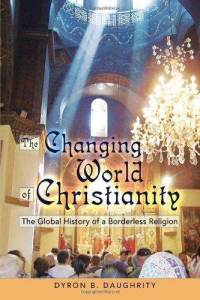 Dyron Daughrity teaches World Christianity at Pepperdine University in southern California. He rightly believes that such a course should now be taught from a global perspective and no longer with the earlier emphases on Europe or North America. Today there are far more Christians in Africa than in Western Europe or North America. The region of Latin America and the Caribbean is easily the most Christianized part of the world. These facts represent a changing of the guard. So this new text book reflects these new positions and stresses not only the geographical spread of Christianity, but also the fact that it is the most global, most diverse and perhaps the most influential religion in history. Such a comprehensive survey in the space of less than three hundred pages requires not only a skilful absorption of secondary sources, but also an ecumenical and eirenic disposition and an ability to adopt a judicious balance between the various components of such a study. It is good to say that Daughrity admirably displays these characteristics. While there is no complete bibliography, each chapter has extensive footnotes for the sources used, as well as questions appended for analysis which are designed to prompt further discussion. Despite some passages which call for greater precision and depth, Daughrity’s lucid style makes for easy undergraduate reading.
Dyron Daughrity teaches World Christianity at Pepperdine University in southern California. He rightly believes that such a course should now be taught from a global perspective and no longer with the earlier emphases on Europe or North America. Today there are far more Christians in Africa than in Western Europe or North America. The region of Latin America and the Caribbean is easily the most Christianized part of the world. These facts represent a changing of the guard. So this new text book reflects these new positions and stresses not only the geographical spread of Christianity, but also the fact that it is the most global, most diverse and perhaps the most influential religion in history. Such a comprehensive survey in the space of less than three hundred pages requires not only a skilful absorption of secondary sources, but also an ecumenical and eirenic disposition and an ability to adopt a judicious balance between the various components of such a study. It is good to say that Daughrity admirably displays these characteristics. While there is no complete bibliography, each chapter has extensive footnotes for the sources used, as well as questions appended for analysis which are designed to prompt further discussion. Despite some passages which call for greater precision and depth, Daughrity’s lucid style makes for easy undergraduate reading.
